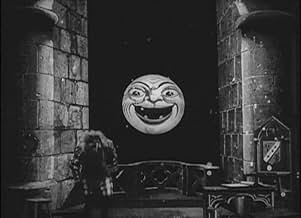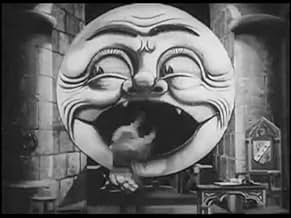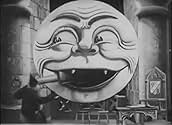IMDb-BEWERTUNG
7,4/10
5099
IHRE BEWERTUNG
Ein Astronom schläft ein und hat einen seltsamen Traum über eine Feenkönigin und den Mond.Ein Astronom schläft ein und hat einen seltsamen Traum über eine Feenkönigin und den Mond.Ein Astronom schläft ein und hat einen seltsamen Traum über eine Feenkönigin und den Mond.
- Regie
- Drehbuch
- Hauptbesetzung
Jehanne d'Alcy
- Phoebe - la bonne fée
- (Nicht genannt)
Georges Méliès
- L'astronome
- (Nicht genannt)
Empfohlene Bewertungen
This is actually a very elaborate fiction film for 1898. Made by Georges Méliès, it lasts over three minutes, when most films during the period lasted about a minute or less. Early cinema historian Frank Gray refers to this film as having consisted of three shots and 60 meters length. Yet, I can't precisely distinguish or separate shots or scenes in it, as the entire film takes place from a fixed framing and long-shot perspective. One could go to either extreme: saying that this is a single shot-scene film since its perspective is stationary, or you could say it consists of dozens of shots, including the trick splices for appearances, disappearances, substitutions and stop-motion animation, which is to say this film is a series of jump cuts.
"The Astronomer's Dream", however, does contain a three-part structure, I'd say. The bookend parts are of the astronomer safe within his laboratory, with the longer, middle part being the nightmare. There are also at least three slightly different decors used: the outer one with the telescope and the entire laboratory; a tighter, less furnished, yet similar one for closer views of the moon during the dream; and, briefly, a wall. Moreover, as indicated by this film having three entries in the Star catalogue, it was available to exhibitors in three parts, which was common then, as films were generally sold in 20-meter lengths. Regardless, this is a sophisticated narrative and production for its time.
The following year, Méliès would produce his first féerie film (fairy film), "Cinderella", which consists of at least four distinct scenes transitioned by dissolves. "Cinderella", albeit, is in the tableau, theatrical style of stationary shot-scenes, but it does distinguish spatially separate scenes for a more advanced narrative construction. One fiction film in 1898, Robert W. Paul's "Come Along Do!" also contained two spatially separate scenes with action continuing across them. "The Astronomer's Dream", however, was Méliès's then most elaborate and sophisticated dream or trick film, although it does contain a fairy godmother type in the goddess Phoebe, who protects the astronomer from attacks by demons, the moon and the rest of the nightmare. It's purely part of what Tom Gunning has referred to as "the cinema of attractions"; the attraction here being the magic or tricks accomplished mostly through substitution splices (a.k.a. stop substitutions), as well as theatrical props and transitions and a brief chalkboard animation within the scene. Today, these trick films hold up well and remain at least amusing because of Méliès's wacky and imaginative humor; their primitiveness is even part of their charm.
"The Astronomer's Dream", however, does contain a three-part structure, I'd say. The bookend parts are of the astronomer safe within his laboratory, with the longer, middle part being the nightmare. There are also at least three slightly different decors used: the outer one with the telescope and the entire laboratory; a tighter, less furnished, yet similar one for closer views of the moon during the dream; and, briefly, a wall. Moreover, as indicated by this film having three entries in the Star catalogue, it was available to exhibitors in three parts, which was common then, as films were generally sold in 20-meter lengths. Regardless, this is a sophisticated narrative and production for its time.
The following year, Méliès would produce his first féerie film (fairy film), "Cinderella", which consists of at least four distinct scenes transitioned by dissolves. "Cinderella", albeit, is in the tableau, theatrical style of stationary shot-scenes, but it does distinguish spatially separate scenes for a more advanced narrative construction. One fiction film in 1898, Robert W. Paul's "Come Along Do!" also contained two spatially separate scenes with action continuing across them. "The Astronomer's Dream", however, was Méliès's then most elaborate and sophisticated dream or trick film, although it does contain a fairy godmother type in the goddess Phoebe, who protects the astronomer from attacks by demons, the moon and the rest of the nightmare. It's purely part of what Tom Gunning has referred to as "the cinema of attractions"; the attraction here being the magic or tricks accomplished mostly through substitution splices (a.k.a. stop substitutions), as well as theatrical props and transitions and a brief chalkboard animation within the scene. Today, these trick films hold up well and remain at least amusing because of Méliès's wacky and imaginative humor; their primitiveness is even part of their charm.
Maybe the first example of science fiction and fantasy in a narrative form from the pioneer of early cinema Georges Melies as he plays an astronomer studying in an observatory when a devil figure appears then a woman who sends the devil away.
The astronomer draws a globe on a blackboard which starts to move, when he looks through the telescope the moon appears with a large face like the face later used in Thomas the Tank Engine cartoons and it eats the astronomer's telescope.
Then small men come through the mouth of the moon and then it goes back in the sky and then the moon becomes a crescent when another figure in the shape of a lady appears.
This is just part of the content in a short film just over three minutes long that has set design, characters in costumes, special effects and use of editing as well as surreal imagery. The editing is jumpy but again it is Melies that was showing the early promise of cinematic illusion.
The astronomer draws a globe on a blackboard which starts to move, when he looks through the telescope the moon appears with a large face like the face later used in Thomas the Tank Engine cartoons and it eats the astronomer's telescope.
Then small men come through the mouth of the moon and then it goes back in the sky and then the moon becomes a crescent when another figure in the shape of a lady appears.
This is just part of the content in a short film just over three minutes long that has set design, characters in costumes, special effects and use of editing as well as surreal imagery. The editing is jumpy but again it is Melies that was showing the early promise of cinematic illusion.
This is another very early (19th century still!!) and simply MAGNIFICENT example of Georges Melies' magic: a queer 'science fiction' story (certainly one of the first EVER) about a scientist (played by Melies himself) who is hooked on his researches about the moon - which seems to take its revenge: first it comes alive on the drawing board, and when he looks at it through its telescope, it comes REALLY close to him, literally only 'a meter away', as the title says; and starts eating up everything in reach...
Here we have the great pleasure to enjoy more of the magician's cinematographic tricks he knew so perfectly well: people and things vanishing and reappearing, the drawn settings seemingly coming alive... THOSE are the 'little' shorts (with a running time of only about 3 minutes then) which led to today's movies with their special computer effects and almost unbelievable scenes - something that EVERY film fan should see in order to get to know the ORIGINS OF TODAY'S CINEMA!
Here we have the great pleasure to enjoy more of the magician's cinematographic tricks he knew so perfectly well: people and things vanishing and reappearing, the drawn settings seemingly coming alive... THOSE are the 'little' shorts (with a running time of only about 3 minutes then) which led to today's movies with their special computer effects and almost unbelievable scenes - something that EVERY film fan should see in order to get to know the ORIGINS OF TODAY'S CINEMA!
An astronomer (dressed like a wizard) is visited in his observatory by various imps and fairies, and eventually a giant, eye-rolling anthropomorphic moon that eats his telescope, dissolves his umbrella, delivers a couple of frolicking moon-children, and eventually eats the old fellow himself. The entire phantasmagoric night turns out to be a dream (hence the original title ('The Astronomer's Dream'), which was more accurate than the deceptive American release "A Trip to the Moon"). The film is a wonderful showcase for Méliès' early experiments in 'trick photography' and includes a number of well done (for the era) substitution splices as the fanciful characters appear and disappear, and a clever animation scene in where images on the astronomer's black-board come to life. A clever and imaginative fantasy film from the early days of cinematography.
'The Astronomer's Dream (1898)' depicts a wacky nightmare than an astronomer has while gazing up at the moon. It involves devilish creatures, heavenly women and grotesque celestial bodies. It's explicitly framed as a dream (primarily via the title), so the piece doesn't have to make a lot of sense. That's good, because it doesn't. It operates on the sort of dream logic that sees ordinary activities morph into battles against otherworldly beings, sees regular objects take on a life of their own and pits a hopelessly logical protagonist against a hopelessly illogical situation. Making ample use of early special effects (mostly those achieved with a well-timed cut), the flick wonderfully achieves its goal of presenting a waking dream to its audience. It's short, sweet and visually impressive. It's still really good considering it came out 100 years before I was even born. 7/10.
Wusstest du schon
- WissenswertesWhen this film was imported into the United States by producer Sigmund Lubin in 1899 he re-titled it A Trip to the Moon. However this has no relation to the 1902 film A Trip to the Moon. The original translated title is "The Moon at One Meter's Distance" or freely "The Moon at Arm's Length".
- VerbindungenFeatured in Castle: Punked (2010)
Top-Auswahl
Melde dich zum Bewerten an und greife auf die Watchlist für personalisierte Empfehlungen zu.
Details
- Erscheinungsdatum
- Herkunftsland
- Sprache
- Auch bekannt als
- The Astronomer's Dream; or, The Man in the Moon
- Drehorte
- Produktionsfirmen
- Weitere beteiligte Unternehmen bei IMDbPro anzeigen
- Laufzeit3 Minuten
- Farbe
- Sound-Mix
- Seitenverhältnis
- 1.33 : 1
Zu dieser Seite beitragen
Bearbeitung vorschlagen oder fehlenden Inhalt hinzufügen

Oberste Lücke
By what name was La lune à un mètre (1898) officially released in Canada in English?
Antwort



















